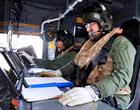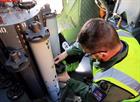Kingfishers and Tigers Go Hunting
Aviators from Culdrose are heading for colder climes, to do what the Merlin helicopter does best… hunt for submarines lurking in the deep.
Earlier this year, the Merlin Force proved they could hunt the enemy below in the warm waters of the Mediterranean. Now Britain’s premier submarine hunters are striking out into the grey expanse of the Atlantic for the biggest exercise of its kind in the ocean for several years.
During the next 3 weeks, the cold North Atlantic waters to the south of Iceland will become a submarine hunting ground for some 11 nations; as Exercise Dynamic Mongoose, a major NATO exercise gets underway. The primary aim of the exercise is to achieve advanced, realistic and challenging Anti-Submarine Warfare (ASW) training for all involved; focusing on Task Group protection with the UK’s NATO allies.
Representing the UK in the hunt are frigate HMS Sutherland and a Merlin Mk2 from RNAS Culdrose – crewed and maintained jointly by 30 personnel from 814 and 829 Squadrons – operating from tanker RFA Wave Ruler. The team hope to build upon their existing ASW skills, and experience gained during Exercise Dynamic Manta in the Mediterranean earlier this year. It will also further strengthen professional relationships within the NATO community.
With the water temperature likely to be no more than 11°C – about 5°C colder than it was off Sicily back in March – the environment (such as temperature layers and salinity of the Atlantic) will play a key role in whether Sutherland’s and the Merlin’s sonar can locate submarines. If they can, they’ll carry out mock attacks with Stingray torpedoes; a flare dropped into the water will signal a successful kill.
The frigate, tanker and Merlin are Britain’s input, taking their place alongside seven warships, half a dozen hunter-killer submarines, eight maritime patrol aircraft and four helicopters – 5,000 personnel in all, drawn from the host country plus the USA, Canada, Denmark, France, Germany, the Netherlands, Norway and Poland.
With over 50 hours of flying planned during the exercise, the crews will be looking to sharpen their deck landings in difficult sea-states before getting stuck-in to the business of hunting the submarines.
Flying from an auxiliary ship will be a little different for the ‘Kingfishers’ of 829 NAS, who normally operate from the smaller Type 23 Frigates. They are however, very acclimatised to working in the tempestuous seas of the North Atlantic. As such, 829 NAS will be able to share their expertise with their colleagues; the ‘Tigers’ of 814 NAS who will be looking to recoup their maritime skills after a busy period supporting operations overseas over the last year, but mainly deployed ashore.
“This is a great opportunity for us to put into practise our core role of hunting submarines in extremely challenging water conditions in an area of strategic value,” said Lt Cdr Kev Murgatroyd of 814 NAS and Detachment Commander for the exercise. “We relish the chance of working with our NATO partners and also combining our efforts between two squadrons.”




